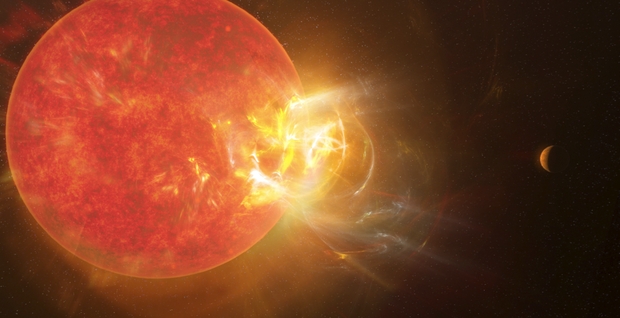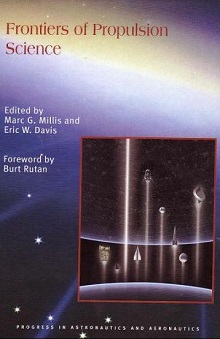The problem of flares in red dwarf planetary systems is stark. With their habitable zones relatively near to the star, planets that might support life are exposed to huge outbursts of particles and radiation that can strip their atmospheres. We can see that in nearby M-dwarfs like Proxima Centauri, which is extremely active not only in visible light but also in radio and millimeter wavelengths. New work at the Atacama Large Millimeter/submillimeter Array (ALMA) digs into the millimeter-wavelength activity. The results do nothing to ease the concern that systems like this may be barren of life.
Small M-dwarf stars are a problem because they operate through convection as energy from fusion at the core is transferred to the surface. A convective structure is one in which hot material from below moves constantly upward, a process that can be likened to what we see in a boiling cauldron of water. Larger stars like the Sun show a mix of radiative transfer – photons being absorbed and reabsorbed as they make their way to the surface – and convection. That enhances M-dwarf flare activity as their plasma is twisted and rotated, producing magnetic fields that snap open only to reconnect. Powerful flares and outbursts of particles are the result.
For a world in an otherwise habitable region around the star, that spells danger. Meredith MacGregor (Johns Hopkins University), who worked with Kiana Burton on the flaring at Proxima Centauri, explains:
“Our Sun’s activity doesn’t remove Earth’s atmosphere and instead causes beautiful auroras, because we have a thick atmosphere and a strong magnetic field to protect our planet. But Proxima Centauri’s flares are much more powerful, and we know it has rocky planets in the habitable zone. What are these flares doing to their atmospheres? Is there such a large flux of radiation and particles that the atmosphere is getting chemically modified, or perhaps completely eroded?”

Image: Artist’s concept of a stellar flare from Proxima Centauri. Credit: NSF/AUI/NSF NRAO/S. Dagnello.
MacGregor and Burton have been working on what they describe as the first multi-wavelength study using millimeter observations to probe into the physics of these flares. At their disposal are 50 hours of ALMA observations, covering some 463 flare events at energies between 1024 to 1027 erg. Most of these flares end quickly, ranging in duration from 3 to 16 seconds. The operative term in the study is flare frequency distribution (FFD), which maps the number of flares against energy levels. A power law function as at optical wavelengths would mean that lower-energy flares would be expected to occur more frequently than flares of higher energy, but the team found many flares within each energy range because of the high flare activity at Proxima.
Adds MacGregor:
“The millimeter flaring seems to be much more frequent–it’s a different power law than we see at the optical wavelengths. So if we only look in optical wavelengths, we’re missing critical information. ALMA is the only millimeter interferometer sensitive enough for these measurements.”
The point is significant, and I want to dig into the paper on this:
Proxima Cen has been observed frequently at optical wavelengths, with a much shallower FFD power-law index of 1.88 ± 0.06. This significant difference could indicate a disconnect between sources of optical and millimeter emission during flares. Since optical observations of stellar flares are more readily available and often used to infer the flaring flux at other wavelengths, this result underlines the need for further multiwavelength campaigns to constrain scaling relations. In particular, the higher rate of millimeter flares compared to optical flares and the tight correlation between FUV and millimeter emission observed by M. A. MacGregor et al. (2021) may suggest that the extreme-UV radiation environment of Proxima b due to small flares is also higher than predicted from the optical flare rate.
So the flare activity at Proxima Centauri is more complicated and perhaps more dangerous than we thought. As we learn more about flaring at this star, we have to hope that Proxima Centauri b has a strong magnetic field that can mitigate the effects of this incoming stream of energy and particles. The prospect of an atmosphere being stripped of ozone and water, for example, makes modification or erosion of its gases a strong possibility. Instruments like the Square Kilometer Array may one day be capable of detecting the interactions between such a magnetic field and the star’s stellar wind. But for now, we can only wait for further data.
The paper is Burton et al., “The Proxima Centauri Campaign — First Constraints On Millimeter Flare Rates from ALMA,” Astrophysical Journal Vol 982, Number 1 (17 March 2025), 43. Preprint / Abstract.



“we have to hope that Proxima Centauri b has a strong magnetic field that can mitigate the effects of this incoming stream of energy and particles”
I doubt this will help. Our magnetic field mostly slows and redirects the particle stream from solar flares and coronal mass ejections (CME) along magnetic field lines, and still impacts the atmosphere. The interaction is complicated.
In the case of a red dwarf planets in the HZ, they are close to the star and often tidally locked. Due to the latter, the magnetic field is likely to be weak. With a strong magnetic field, the lit hemisphere will still be severely eroded. Since the atmosphere is a fluid, that will deplete the entire atmosphere. Charged particles (protons are the major threat) will follow those field lines and attack the dark side atmosphere directly.
I find it difficult to be optimistic about habitable planets around red dwarfs.
Ron, The loss should approach a limit when the atmosphere and water will freeze out on the dark side, won’t be much is my guess.
We are still speculating beyond the data. While we cannot get atmosphere composition data from Proxima Centauri b as it is not a planet detectable by transits (AFAIK), we should look at comparable stars with transiting planets and develop the technology to detect the presence and composition of their planets in their [C]HZ orbits. This should end the speculation and pave the way for elucidating habitability based on likely atmospheres even for planets around M_dwarfs of varying age that are not directly observable.
Does anyone here have any idea when our telescopes might be able to detect rocky planet atmospheres rather than those of gas giants?
We also don’t know how old the Proxima Centauri system is, but we think it is a little older than our Sun. Consequently, Proxima b may have lost a lot of atmosphere through solar wind stripping and the extra energy from the ultra violet and x rays and photolysis of carbon dioxide into oxygen and carbon and water vapor can cause oxygen gas escape. Google AI
The extremely large telescope won’t be ready until 2028, but it will have a chronograph and even light polarization techniques. Getting some spectral lines of Proxima b will be revealing of it’s atmospheric history.